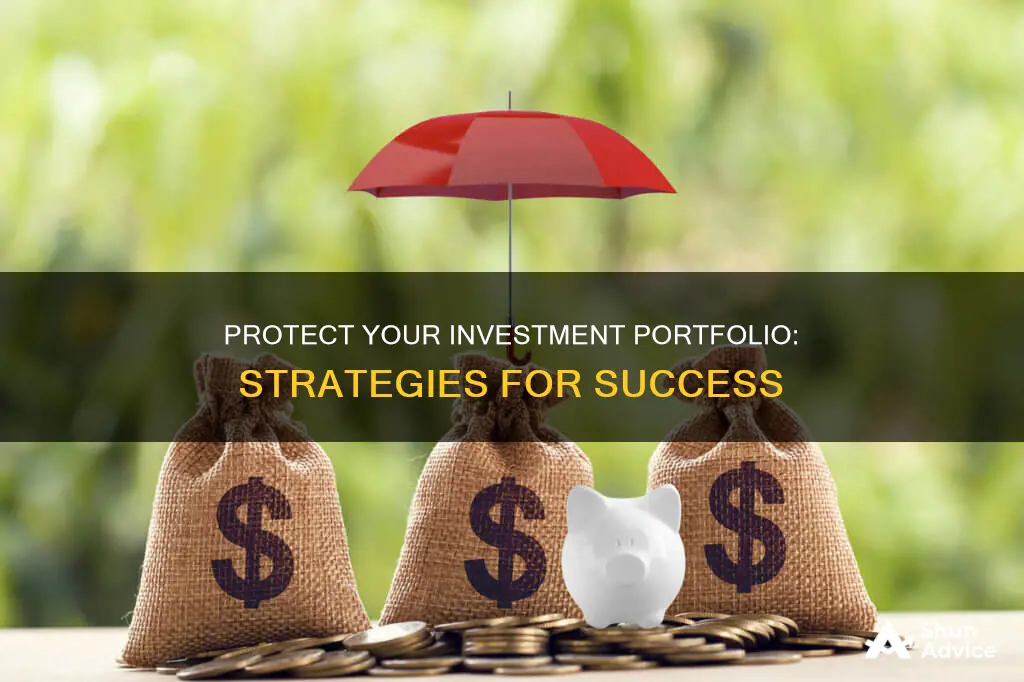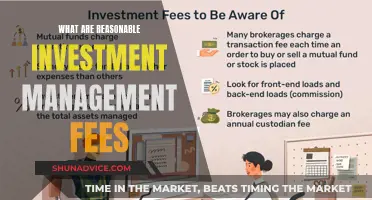
The stock market can be a volatile place, and investors need to be prepared for downturns and crashes. While it's impossible to avoid risk entirely, there are several strategies that can help protect your investment portfolio. Here are some key steps to consider:
- Diversification: Spread your investments across different asset classes, such as stocks, bonds, commodities, real estate, and cash. By investing in a variety of industries and sectors, you can reduce unsystematic risk and smooth out the overall volatility of your portfolio.
- Non-Correlating Assets: Add assets that don't move in tandem with the stock market, such as bonds, commodities, currencies, and real estate. These assets can provide more balanced returns and protect against systematic risk.
- Put Options and Stop-Loss Orders: Use put options to bet against rising stock prices and stop-loss orders to automatically trigger the sale of a stock at a fixed price. These tools can help limit losses when investment prices start to drop.
- Dividend-Paying Stocks: Invest in companies that pay dividends, as they can provide a cushion during market downturns and increase your overall return.
- Principal-Protected Notes: Consider investing in fixed-income securities that guarantee the return of your principal investment, providing protection against potential losses.
- Research and Due Diligence: Always research your investments and investment professionals thoroughly before committing your money. Be cautious of investment scams and regularly monitor your accounts for any suspicious activity.
- Cash Reserves: Keep a portion of your portfolio in cash to cover short-term spending and reduce volatility. This ensures that you have funds available during market downturns and can take advantage of new investment opportunities.
| Characteristics | Values |
|---|---|
| Research investments | Research before investing and be aware of investment scams. |
| Research investment professionals | Only work with licensed and registered investment professionals. |
| Understand fees | Be aware of fees and costs that come with investments. |
| Monitor accounts | Monitor your accounts for suspicious activity and unfamiliar changes. |
| Diversify holdings | Diversify holdings over different asset classes and choose non-correlating assets. |
| Non-correlating assets | Add non-correlating asset classes such as bonds, commodities, currencies and real estate. |
| Put options | Buy put options to bet that the underlying stock will go down in price. |
| Stop-loss orders | Use stop-loss orders to trigger the sale of a stock at a fixed price. |
| Dividends | Invest in dividend-paying stocks to increase your overall return. |
| Principal-protected notes | Consider principal-protected notes if you're concerned about your principal. |
| Cash on hand | Keep cash on hand for short-term spending. |
| Bonds | Add bonds to your mix for more stable returns. |
| International diversification | Diversify internationally to capture growth wherever it happens. |
| Commodity exposure | Include commodities like gold, oil or lumber in your portfolio. |
What You'll Learn

Research investments and investment professionals
Researching investments and investment professionals is a critical aspect of protecting your investment portfolio. Here are some detailed guidelines to help you navigate this process effectively:
Researching Investments:
Due diligence is essential when researching investments. Before investing, carefully review disclosures provided by companies, bond issuers, mutual funds, and ETFs. This information is available for free on EDGAR and can help you make informed decisions. These disclosures include details such as financial statements, economic indicators, and market trends, enabling you to assess the potential risks and returns of an investment opportunity.
Additionally, consider the following:
- Understand the fees and costs associated with investments, as they can have a significant impact on your portfolio over time.
- Be cautious of investment scams. Learn the red flags, such as unregistered companies, and always research investment professionals before handing over your money.
- Monitor your investment accounts regularly for any suspicious activity or unauthorized changes to your account information.
Researching Investment Professionals:
When choosing to work with an investment professional, such as a financial advisor or investment analyst, it is crucial to conduct thorough research. Here are some key considerations:
- Always verify the investment professional's license and registration status. Ensure they are licensed and registered to provide investment services.
- Look into their background and any disciplinary history. Understanding their qualifications, experience, and reputation can help you assess their credibility and expertise.
- Understand the fees you will be paying for their services. Be aware of any additional costs or miscellaneous fees that may impact your investment portfolio over time.
- Consider the benefits of working with a financial advisor. While they may charge a fee, a good financial advisor can add value to your portfolio by providing informed guidance and helping you navigate market volatility.
Savings and Investment: Interplay in a Closed Economy
You may want to see also

Diversify holdings over asset classes
Diversifying your holdings over asset classes is a cornerstone of modern portfolio theory (MPT). In a market downturn, disciples of the MPT believe that a well-diversified portfolio will outperform a concentrated one.
Diversification is about variety. It's about spreading your investments across different asset classes, like stocks, bonds, and cash or cash equivalents. It's also about spreading your investments within those asset classes. For example, if you're investing in stocks, you might want to own multiple stocks of different-sized companies (small, medium, and large), from different sectors (technology, consumer, healthcare, etc.), and from different geographies (domestic and international).
The goal of diversification is to create a portfolio that can weather market volatility. When one asset class is down, another may be up, smoothing out the highs and lows in performance and reducing the impact of market fluctuations on your investments.
- Understand the different asset classes: Familiarize yourself with the various asset classes available to you, such as stocks, bonds, cash or cash equivalents, options, futures, commodities, and real estate. Each asset class has its own risk and return characteristics, so it's important to understand them before investing.
- Determine your risk tolerance: How comfortable are you with taking risks? This will influence your asset allocation. If you have a low-risk tolerance, you may want to allocate more of your portfolio to less risky asset classes like bonds or cash. On the other hand, if you have a higher risk tolerance, you may want to allocate more to stocks or other riskier investments.
- Diversify within asset classes: As mentioned earlier, diversification within asset classes is just as important as diversification across asset classes. For example, if you're investing in stocks, consider investing in a variety of companies of different sizes, from different sectors, and from different countries. This will help reduce the risk of major losses that can result from over-emphasizing a single security or asset class.
- Consider pooled investments: Pooled investments like mutual funds and exchange-traded funds (ETFs) are a great way to achieve diversification. These funds typically include a large number and variety of underlying investments, spreading out your risk. However, be sure to check that the pooled investments you choose are indeed diversified.
- Regularly review and rebalance your portfolio: Market performance can alter the values of your asset classes over time, affecting the balance of growth and return in your portfolio. Therefore, it's important to regularly review your portfolio and make adjustments to realign with your original asset allocation. This process is known as rebalancing. While there's no official timeline for rebalancing, some people choose to do it annually as part of a yearly investment review.
Adjusting Your Investment Portfolio: Strategies for Success
You may want to see also

Keep cash on hand for short-term spending
Keeping cash on hand for short-term spending is a critical part of protecting your investment portfolio, especially for retirees and investors with shorter-term spending needs. Here's how you can do it:
Understand the Role of Cash in Your Portfolio
Cash in your portfolio provides safety and liquidity. It is a safe asset because it is supported by the full faith and credit of the government, and it is the most liquid asset, easily accessible for purchases, transfers, and payments. While cash offers lower returns compared to other investments, it is a vital component for short-term spending needs.
Assess Your Life Stage and Spending Needs
The amount of cash you should keep on hand depends on your life stage and spending requirements. If you are many years away from retirement, you may not need to allocate as much cash, assuming you have an emergency fund and sufficient liquid assets to cover short-term expenses. However, as you get closer to retirement, it is generally recommended to keep at least one to two years' worth of expenses in cash or other low-risk assets. This ensures you have a ready source of liquidity and avoids the need to sell stocks or bonds during a market downturn.
Explore Various Cash Holding Options
There are several options for holding cash, each with its pros and cons:
- Bank savings account: FDIC-insured up to $250,000, easily accessible, but typically offers lower returns.
- Money market account: FDIC-insured, may offer check writing, but returns tend to be relatively low.
- Certificate of deposit (CD): FDIC-insured, can lock in the current rate for a set period, but may require a minimum investment amount and have an early withdrawal penalty.
- Under the mattress/hidden storage: Easily accessible in emergencies, but provides poor returns and carries a risk of theft.
Maintain an Emergency Fund
Regardless of your life stage, it is generally recommended to keep at least six to twelve months' worth of living expenses in cash as an emergency fund. This ensures you have a buffer to cover unexpected expenses or financial setbacks, such as job loss, car repairs, or appliance replacements.
Strategically Diversifying Your Investment Portfolio: A Smart Investor's Guide
You may want to see also

Monitor your investment accounts
Monitoring your investment accounts is a crucial step in protecting your investment portfolio. Here are some detailed instructions and strategies to help you effectively monitor your investment accounts:
Understand the Importance of Monitoring
Monitoring your investment accounts is essential to protect your financial interests and make informed decisions. It helps you track the performance of your investments, identify any suspicious or unauthorised activities, and ensure that your investments are aligned with your financial goals.
Choose a Suitable Portfolio Management App
Utilise a portfolio management app that suits your needs and investment style. Look for features such as real-time data, performance dashboards, tracking and planning tools, retirement planning, fee monitoring, and customisation options. Some popular apps include Empower, SigFig Wealth Management, Sharesight, and Yahoo Finance.
Sync Your Investment Accounts
Most portfolio management apps allow you to sync your investment and banking accounts, providing a comprehensive view of your financial situation. By syncing your accounts, you can easily track your investments across different platforms and receive up-to-date information on their performance.
Analyse Your Investment Portfolio
Regularly review the performance of your investments and compare them against benchmark indices or funds. Assess your asset allocation and diversification to ensure they align with your risk tolerance and financial goals. Monitor your risk levels and adjust your portfolio as needed to reduce exposure to specific investments or sectors.
Stay Alert for Suspicious Activity
Be vigilant about any unauthorised transactions or changes to your account information. Regularly review your account statements and confirm that all transactions are accurate and authorised by you. This proactive approach will help protect your investments from potential fraud or identity theft.
Seek Professional Advice
Consider consulting a financial advisor or investment professional, especially if you feel overwhelmed or uncertain about monitoring your investment accounts effectively. They can provide guidance, help you interpret data, and make informed decisions to protect and grow your investment portfolio.
By diligently monitoring your investment accounts, you can make more informed decisions, protect your financial interests, and work towards achieving your investment goals.
Strategies to Optimize Your Investment Portfolio for Maximum Returns
You may want to see also

Consider investing in real assets
Investing in real assets, such as securities with exposure to tangible assets like infrastructure, real estate, and natural resources, can be a great way to protect your investment portfolio. Here are some reasons why you should consider investing in real assets:
Hedge Against Inflation
Real assets tend to increase in value along with inflation. They can contractually or directly pass on higher prices to consumers, allowing investors to keep pace with inflation. For example, investing in dividend-paying stocks or companies that pay generous dividends can result in higher overall returns and act as a cushion during market downturns.
Competitive Returns
Stocks and funds with exposure to real assets can generate consistent income streams, regardless of the economic environment or short-term market fluctuations. Real assets may also outperform during periods of higher nominal economic growth.
Diversification Potential
Real assets, such as non-correlating assets, have traditionally had low correlations to other stocks and to each other. This means that their value does not closely track the performance of other assets. By adding non-correlating assets like bonds, commodities, currencies, and real estate to your portfolio, you can reduce systematic risk and smooth out the volatility of your portfolio's overall worth.
Long-Term Stability and Capital Appreciation
Real assets, such as real estate, can hold long-term value well, even during recessions. They provide long-term stability and the potential for capital appreciation.
Access to Non-Residential Investments
By investing in real assets through vehicles like real estate investment trusts (REITs), you can gain access to non-residential investments such as malls or office buildings, which are typically not feasible for individual investors to purchase directly.
Risk Mitigation
While real assets are not without risk, you can mitigate potential risks by being selective and choosing companies with strong balance sheets, reasonable valuations, and attractive dividend yields. Additionally, consider factors such as their sensitivity to economic growth, the impact of interest rate changes, potential regulatory developments, and the risk of long-term shifts in demand.
In conclusion, investing in real assets can provide a hedge against inflation, generate competitive returns, and offer diversification benefits to your investment portfolio. By being selective and considering various types of real assets, you can enhance the stability and performance of your portfolio while managing potential risks.
Investing vs. Saving: Brainly's Guide to Financial Strategies
You may want to see also
Frequently asked questions
The cardinal rule of investing is: Protect and preserve your principal.
It's natural to want to sell and leave the stock market altogether when stock prices decline. However, investors who make this step turn a temporary loss into a permanent one. Instead, pause and think, and consider holding on and waiting for the market to rebound.
Implementing well-respected portfolio management strategies and creating an appropriate mix of stocks, bonds, and cash for your age, time horizon, and risk tolerance can help you prepare for a stock market crash.
One way to protect your portfolio from a market downturn is to increase your cash position. Cash investments have no risk of principle, so they will at least hold their value during times of volatility.
Remember to do your due diligence by researching before you invest. Carefully review disclosures from companies, bond issuers, mutual funds, and ETFs, which are available for free on EDGAR.







